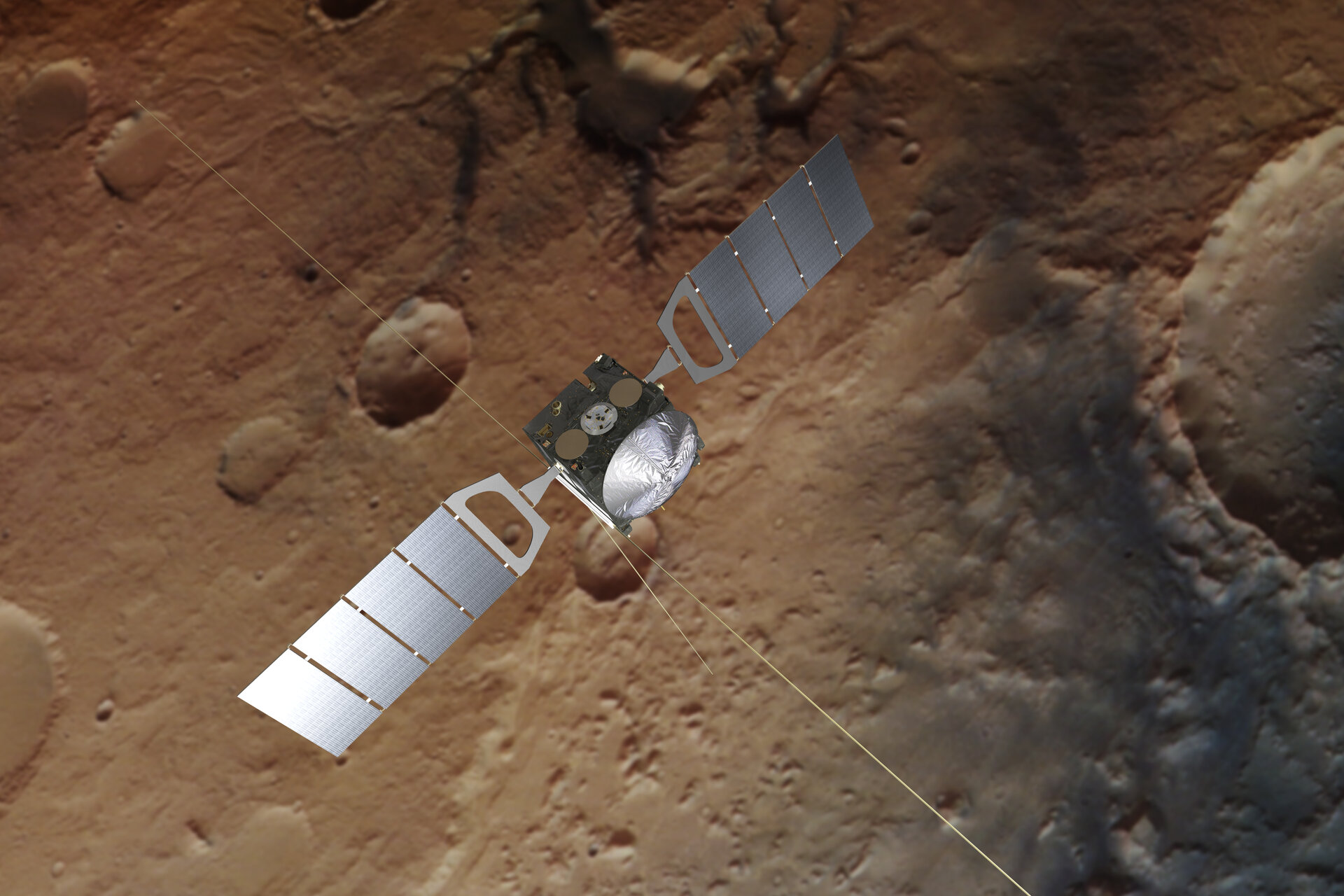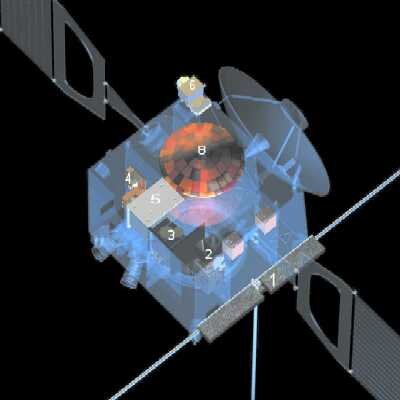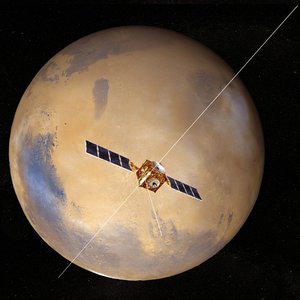Mars Express orbiter instruments
Orbiter scientific payload
- Surface/subsurface instruments
- HRSC (High Resolution Stereo Camera)
- OMEGA (Visible and Infrared Mineralogical Mapping Spectrometer)
- MARSIS (Sub-surface Sounding Radar Altimeter)
- Atmosphere and plasma instruments
- PFS (Planetary Fourier Spectrometer)
- SPICAM (Ultraviolet and Infrared Atmospheric Spectrometer)
- ASPERA (Energetic Neutral Atoms Analyser)
- MaRS (Mars Radio Science Experiment)
- Visual Monitoring Camera (VMC)
High Resolution Stereo Camera (HRSC)
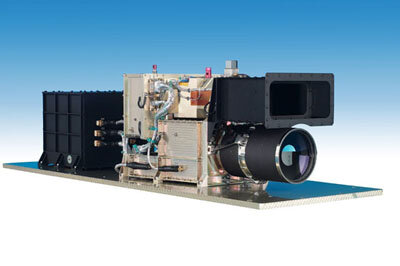
The HRSC is imaging the entire planet in full colour, 3D and with a resolution of about 10 metres. Selected areas will be imaged at two-metre resolution. One of the camera's greatest strengths will be the unprecedented pointing accuracy achieved by combining images at the two different resolutions. Another will be the 3D imaging which will reveal the topography of Mars in full colour.
HRSC a multi-sensor pushbroom instrument comprising multiple charge coupled device (CCD) line sensors mounted in parallel for simultaneous high-resolution stereo, multicolour and multi-phase imaging of the martian surface. An additional Super Resolution Channel provides frame images embedded in the basic HRSC swath at five times greater resolution.
"The strength of HRSC is to perform high resolution digital terrain models of the martian surface in order to provide topographic context for the geoscientific evaluation of surface processes in space and time,” says Ralf Jaumann, previous HRSC Principal Investigator from the Institute of Planetary Research, DLR, Berlin, Germany.
Visible and Infrared Mineralogical Mapping Spectrometer (OMEGA)
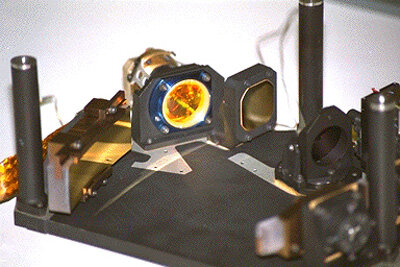
OMEGA (Observatoire pour la Minéralogie, l'Eau, les Glaces et l'Activité) builds up maps of the surface mineral composition from the visible and infrared light reflected from the planet's surface in the wavelength range 0.5-5.2 microns. As the light reflected from the surface passes through the atmosphere before entering the instrument, OMEGA also measures the atmospheric composition.
"We want to know the iron content of the surface, the water content of the rocks and clay minerals and the abundance of non-silicate materials such as carbonates and nitrates. These measurements would allow us to reconstruct the history of the planet," says Jean-Pierre Bibring, previous OMEGA Principal Investigator from the Institut d’Astrophysique Spatiale, Orsay, France.
Ultraviolet and Infrared Atmospheric Spectrometer (SPICAM)
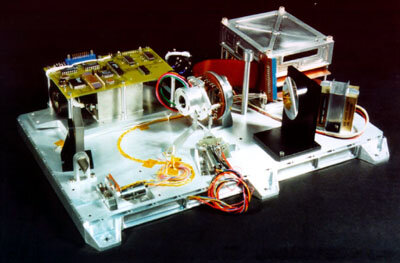
SPICAM (Spectroscopy for the Investigation of the Characteristics of the Atmosphere of Mars) determines the composition of the martian atmosphere by measuring the light that passes though the atmosphere. The ultraviolet sensor measures ozone absorbing 0.25 micron light, while the infrared channel measures water vapour that absorbs at 1.38 micron. The instrument looks in nadir and also works in solar and stellar occultation geometry, enabling vertical profiling of the atmospheric constituents.
"Over the mission lifetime we build up comprehensive climatology of ozone and water vapour and monitor the dust cycle as well as perform key measurements of emissions in the upper atmosphere," says Franck Montmessin, SPICAM Principal Investigator from, LATMOS, Guyancourt, France.
Planetary Fourier Spectrometer (PFS)
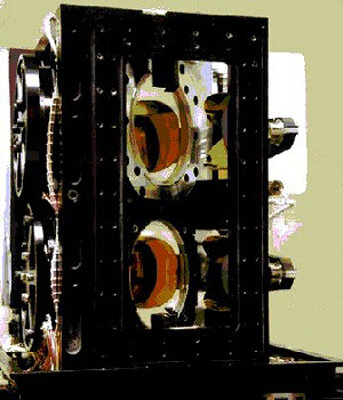
The PFS determines the composition and structure of the martian atmosphere by measuring the sunlight absorbed by molecules and the infrared radiation they emit in the range 1.2–45 microns. In particular, PFS builds long-term, global scale maps of vertical temperature profiles in the atmosphere, as well as complete climate records of water vapour and carbon monoxide. The instrument is also continuously looking for minor constituents including methane, hydrogen peroxide and formaldehyde.
"We hope to get many, many measurements so that by taking the average of thousands we'll be able to see minor species," says Marco Giuranna, PFS Principal Investigator from Istituto Fisica Spazio Interplanetario, Rome, Italy.
Analyzer of Space Plasma and Energetic Atoms (ASPERA-3)

ASPERA-3 measures ions, electrons and energetic neutral atoms in the outer atmosphere to reveal the numbers of oxygen and hydrogen atoms (the constituents of water) interacting with the solar wind and the regions of such interaction. Constant bombardment by the stream of charged particles pouring out from the Sun is thought to be responsible for the losses from the martian atmosphere. The planet no longer has a global magnetic field to deflect the solar wind, which is consequently free to interact unhindered with atoms of atmospheric gas and sweep them out to space.
"We will be able to see this plasma escaping the planet and so estimate how much atmosphere has been lost over billions of years," says Mats Holmström, ASPERA Principal Investigator from the Swedish Institute of Space Physics in Kiruna, Sweden.
Mars Radio Science Experiment (MaRS)
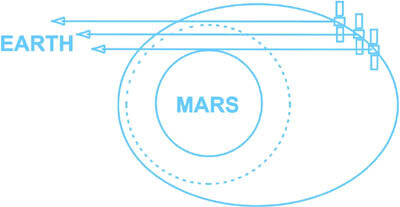
MaRS uses the radio signals that convey data and instructions between the spacecraft and antenna on Earth to probe the planet's ionosphere, atmosphere, surface and even the interior. When the spacecraft disappears behind Mars or appears from behind the planet as seen from Earth (radio-occultation) the radio signal is modulated by the atmosphere. Resulting changes in frequency and power of the radio signal are used to derive the structure of the neutral atmosphere and ionosphere. Information on the interior is gleaned from the planet's gravity field, which is calculated from the changes in the velocity of the spacecraft relative to Earth. The surface roughness is deduced from the way in which the radio waves are reflected from the martian surface.
"Variations in the gravitational field of Mars will cause slight changes in the speed of the spacecraft relative to the ground station, which can be measured with an accuracy of less than one tenth the speed of a snail at full pace," says Martin Pätzold, MaRS Principal Investigator from Rheinishes Institut für Umweltforschung at Köln University, Germany.
Mars Advanced Radar for Subsurface and Ionospheric Sounding (MARSIS)
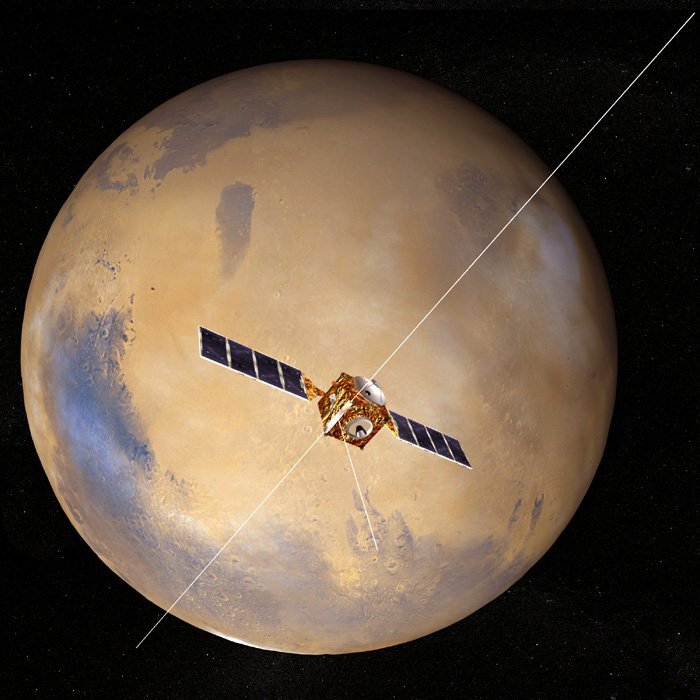
MARSIS is mapping the sub-surface structure to a depth of a few kilometres. The instrument's 40-metre long antenna sends low frequency radio waves towards the planet, which are reflected from any surface or subsurface boundary they encounter. For most, this will be the surface of Mars, but a significant fraction travels through the crust to be reflected at sub-surface interfaces between layers of different material, including ice, soil and rock.
"We can measure the thickness of the polar caps and estimate their composition. We are also probing volcanic and sedimentary rock layers outside of the polar regions," says Roberto Orosei, MARSIS Principal Investigator from Instituto Nazionale di Astrofisica, Italy. “MARSIS is also studying the ionosphere, as this electrically charged region of the upper atmosphere reflects and modifies some radio waves.”
Visual Monitoring Camera (VMC)
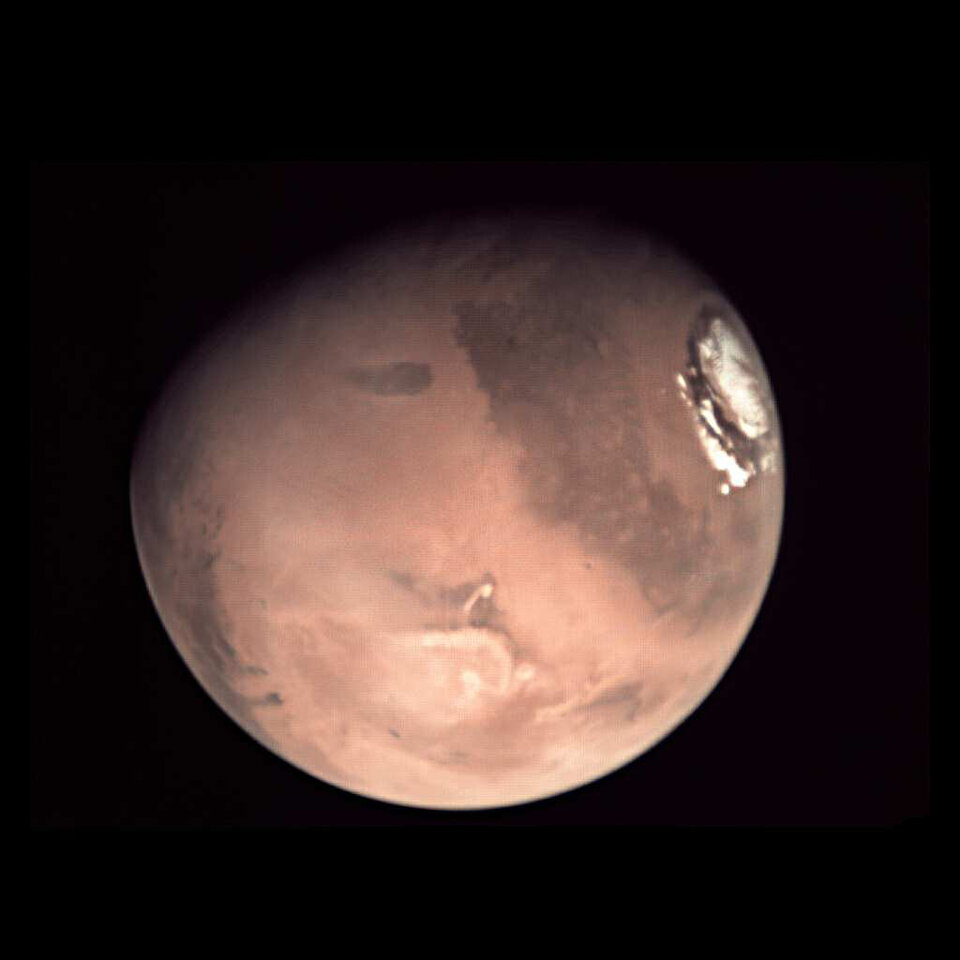
VMC is the engineering camera installed on board the spacecraft to confirm separation of the Beagle-2 lander. Since 2007 VMC has been used for public outreach purposes and became known as “Mars webcam”.
“Since it was reactivated, this small camera has done a fantastic job in regular imaging of the planet, and through its outreach activities and social media channels is helping bring Mars closer to the public,” says Simon Wood, Mars Express spacecraft operations engineer at ESOC, Darmstadt.
In 2016 ESA began working on the conversion of the humble camera into a professional science instrument. “The VMC context images strongly complement HRSC and OMEGA observations by providing regular global monitoring of clouds, dust and atmospheric structures as well as characterization of transient surface features like frosts and polar caps,” says Agustín Sánchez-Lavega, the VMC team lead at the University of the Basque Country, Bilbao, Spain.
VMCs image processing is automated, meaning that the latest observations are processed and uploaded shortly after arriving on Earth. The VMC blog contains the archive of raw data files whilst processed images are uploaded to the cameras own flickr account. When new images are available VMC notifies the world via its Twitter account @esamarswebcam.


